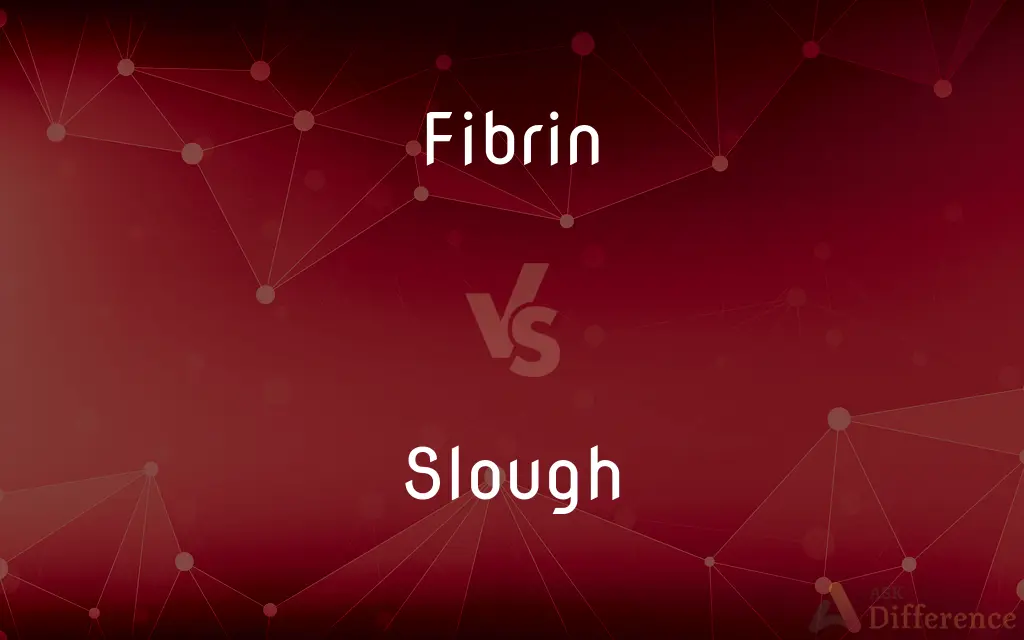Fibrin vs. Slough — What's the Difference?
By Tayyaba Rehman — Updated on October 27, 2023
Fibrin is a protein essential for blood clotting, while slough is dead tissue that sheds or peels away, often seen in wounds.

Difference Between Fibrin and Slough
Table of Contents
ADVERTISEMENT
Key Differences
Fibrin forms a mesh-like structure in blood clots. Slough, however, is dead tissue detaching from a wound.
While fibrin is integral in healing, slough can indicate delayed healing.
Fibrin's presence is vital in the initial stages of wound repair. Slough typically appears when there's an impediment to healing.
Fibrin is produced by the action of thrombin. Slough results from tissue necrosis or damage.
In medical treatment, managing fibrin involves balancing clotting. Managing slough involves wound debridement.
ADVERTISEMENT
Comparison Chart
Definition
Protein for blood clotting.
Dead tissue shedding from a wound.
Role in Healing
Essential for initial healing.
Indicates delayed or impaired healing.
Formation
Produced by thrombin.
Results from tissue necrosis or damage.
Medical Management
Involves clotting balance.
Often requires debridement.
Significance
Indicates normal healing process.
Can signal infection or other issues.
Compare with Definitions
Fibrin
Blood Clotting Protein
Fibrin plays a crucial role in blood clotting.
Slough
Shedding Tissue
Slough is the tissue that sheds from a wound.
Fibrin
Coagulation Factor
Fibrin is essential in the coagulation cascade.
Slough
Healing Impediment
Slough can impede wound healing.
Fibrin
Mesh-Like Structure
Fibrin forms a mesh to stop bleeding.
Slough
Necrotic Tissue
Slough consists of necrotic or dead tissue.
Fibrin
Wound Healing Component
Fibrin helps in the healing of wounds.
Slough
Debridement Concern
Slough may require surgical debridement.
Fibrin
Fibrin (also called Factor Ia) is a fibrous, non-globular protein involved in the clotting of blood. It is formed by the action of the protease thrombin on fibrinogen, which causes it to polymerize.
Slough
Slough () is a large town in Berkshire, England (within the historic county of Buckinghamshire), 20 miles (32 km) west of central London (Charing Cross) and 19 miles (31 km) north-east of Reading. It is in the Thames Valley and within the London metropolitan area at the intersection of the M4, M40 and M25 motorways.
Fibrin
An elastic, insoluble, whitish protein produced by the action of thrombin on fibrinogen and forming an interlacing fibrous network in the coagulation of blood.
Slough
A town in south-eastern England to the west of London; population 119,400 (est. 2009).
Fibrin
A white, albuminous, fibrous substance, formed in the coagulation of the blood.
Slough
Shed or remove (a layer of dead skin)
A snake sloughs off its old skin
Exfoliate once a week to slough off any dry skin
Fibrin
An elastic, insoluble, whitish protein produced by the action of thrombin on fibrinogen and forming an interlacing fibrous network in the coagulation of blood.
Slough
(of soil or rock) collapse or slide into a hole or depression
An eternal rain of silt sloughs down from the edges of the continents
Fibrin
An albuminous body, resembling animal fibrin in composition, found in cereal grains and similar seeds; vegetable fibrin.
Slough
A depression or hollow, usually filled with deep mud or mire.
Fibrin
To apply fibrin sealant to a surgical site to either stop bleeding or for surgical flap closure.
Slough
Also slue A swamp, marsh, bog, or pond, especially as part of a bayou, inlet, or backwater.
Fibrin
A white, albuminous, fibrous substance, formed in the coagulation of the blood either by decomposition of fibrinogen, or from the union of fibrinogen and paraglobulin which exist separately in the blood. It is insoluble in water, but is readily digestible in gastric and pancreatic juice.
Slough
A state of deep despair or moral degradation.
Fibrin
The white, albuminous mass remaining after washing lean beef or other meat with water until all coloring matter is removed; the fibrous portion of the muscle tissue; flesh fibrin.
Slough
The dead outer skin shed by a reptile or amphibian.
Fibrin
An albuminous body, resembling animal fibrin in composition, found in cereal grains and similar seeds; vegetable fibrin.
Slough
(Medicine)A layer or mass of dead tissue separated from surrounding living tissue, as in a wound, sore, or inflammation.
Fibrin
A white insoluble fibrous protein formed by the action of thrombin on fibrinogen when blood clots; it forms a network that traps red cells and platelets
Slough
An outer layer or covering that is shed or removed.
Fibrin
Thrombin's Product
Thrombin converts fibrinogen to fibrin.
Slough
To be cast off or shed; come off
"smooth fallen branches from which all bark has sloughed" (David M. Carroll).
Slough
To shed a slough
Every time that a snake sloughs.
Slough
(Medicine)To separate from surrounding living tissue. Used of dead tissue.
Slough
To cast off or shed (skin or a covering)
Came inside and sloughed off his coat.
Slough
To discard or disregard as undesirable or unfavorable
Sloughed off her misgivings.
Slough
The skin shed by a snake or other reptile.
That is the slough of a rattler; we must be careful.
Slough
Dead skin on a sore or ulcer.
This is the slough that came off of his skin after the burn.
Slough
(British) A muddy or marshy area.
Slough
(Eastern United States) A type of swamp or shallow lake system, typically formed as or by the backwater of a larger waterway, similar to a bayou with trees.
We paddled under a canopy of trees through the slough.
Slough
(Western United States) A secondary channel of a river delta, usually flushed by the tide.
The Sacramento River Delta contains dozens of sloughs that are often used for water-skiing and fishing.
Slough
A state of depression.
John is in a slough.
Slough
(Canadian Prairies) A small pond, often alkaline, many but not all formed by glacial potholes.
Potholes or sloughs formed by a glacier’s retreat from the central plains of North America, are now known to be some of the world’s most productive ecosystems.
Slough
(transitive) To shed (skin).
This skin is being sloughed.
Snakes slough their skin periodically.
Slough
(intransitive) To slide off (like a layer of skin).
A week after he was burned, a layer of skin on his arm sloughed off.
Slough
To discard.
East sloughed a heart.
Slough
To commit truancy, be absent from school without permission.
Slough
Slow.
Slough
A place of deep mud or mire; a hole full of mire.
He's here stuck in a slough.
Slough
A wet place; a swale; a side channel or inlet from a river.
Slough
The skin, commonly the cast-off skin, of a serpent or of some similar animal.
Slough
The dead mass separating from a foul sore; the dead part which separates from the living tissue in mortification.
Slough
To form a slough; to separate in the form of dead matter from the living tissues; - often used with off, or away; as, a sloughing ulcer; the dead tissues slough off slowly.
Slough
To cast off; to discard as refuse.
New tint the plumage of the birds,And slough decay from grazing herds.
Slough
Necrotic tissue; a mortified or gangrenous part or mass
Slough
A hollow filled with mud
Slough
A stagnant swamp (especially as part of a bayou)
Slough
Any outer covering that can be shed or cast off (such as the cast-off skin of a snake)
Slough
Cast off hair, skin, horn, or feathers;
Out dog sheds every Spring
Slough
Dead Tissue in Wounds
Slough often appears in chronic wounds.
Common Curiosities
How is excessive fibrin treated?
Often with anticoagulant medications.
Is fibrin always beneficial?
Generally, but excessive fibrin can cause clots.
Can fibrin be seen in blood tests?
Yes, particularly in coagulation tests.
Does slough have a color?
It's often yellowish or white.
Does slough always indicate infection?
Not always, but it can be a sign.
Can slough heal on its own?
Sometimes, but medical intervention helps.
Is slough part of normal healing?
Not typically; it suggests complications.
Can fibrin levels be too low?
Yes, leading to poor clotting.
Is fibrin involved in minor cuts?
Yes, it plays a role in all wound healing.
Can slough appear in surgical wounds?
It can, indicating healing issues.
Is slough painful?
It can be, especially in severe wounds.
Does fibrin dissolve eventually?
Yes, as part of the healing process.
Are there diseases affecting fibrin?
Yes, like clotting disorders.
Is managing fibrin important in surgery?
Absolutely, to prevent excessive bleeding or clots.
Can slough indicate diabetes?
It's more common in diabetic wounds.
Share Your Discovery

Previous Comparison
Gif vs. Jpeg
Next Comparison
Cellulose vs. FiberAuthor Spotlight
Written by
Tayyaba RehmanTayyaba Rehman is a distinguished writer, currently serving as a primary contributor to askdifference.com. As a researcher in semantics and etymology, Tayyaba's passion for the complexity of languages and their distinctions has found a perfect home on the platform. Tayyaba delves into the intricacies of language, distinguishing between commonly confused words and phrases, thereby providing clarity for readers worldwide.














































